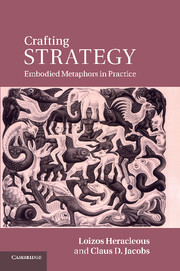Book contents
- Frontmatter
- Contents
- List of figures
- List of tables
- Preface
- Acknowledgments
- Vignette A BASF PerForm
- Vignette B UNICEF
- Vignette C Project Voltigo
- Vignette D Hephata Foundation
- 6 Understanding organizations through embodied metaphors
- 7 Sensemaking through embodied metaphors in organization development
- Vignette E Privatbank IHAG Zürich AG
- Vignette F World Vision New Zealand
- Glossary
- Index
- References
6 - Understanding organizations through embodied metaphors
Published online by Cambridge University Press: 05 June 2011
- Frontmatter
- Contents
- List of figures
- List of tables
- Preface
- Acknowledgments
- Vignette A BASF PerForm
- Vignette B UNICEF
- Vignette C Project Voltigo
- Vignette D Hephata Foundation
- 6 Understanding organizations through embodied metaphors
- 7 Sensemaking through embodied metaphors in organization development
- Vignette E Privatbank IHAG Zürich AG
- Vignette F World Vision New Zealand
- Glossary
- Index
- References
Summary
In Chapter 2 we outlined the key theoretical antecedents to crafting strategy through embodied metaphors, drawing from literature on metaphor and embodied realism. We portrayed metaphor as a creative force, addressing the cognitive, spatial and embodied dimensions. We also addressed the theoretical development of metaphor in the context of organization development interventions, a context we exemplify in this chapter. We operationalize the embodied metaphor approach in a study of three organization development workshops where groups of actors were engaged in constructing metaphors in the flesh: physical entities whose target domains were their task, their organization in its business landscape, and the identity of their division. In doing so, participants drew on a variety of source domains, and the resulting metaphors produced insights for them in terms of developing shared views of their target domains, as well as for us as researchers through a three-stage analytical process involving contextual understanding, within-case analysis and cross-case analysis.
We analyzed grand metaphors and constituent metaphors constructed by these teams, and found that actors' first-order perceptions of organizational dimensions such as power, importance, relatedness, coherence, belongingness, robustness/duality of relationships, and uniformity, are manifested in particular ways in these embodied metaphors, through the spatial arrangement of physical objects. We found that analysis of embodied metaphors can enable access to actors' first-order conceptions of organizational dimensions, revealing alternative qualities and interrelations among them, and posing substantial challenges to established conceptions of ontology and method in organization theory.
Information
- Type
- Chapter
- Information
- Crafting StrategyEmbodied Metaphors in Practice, pp. 121 - 155Publisher: Cambridge University PressPrint publication year: 2011
